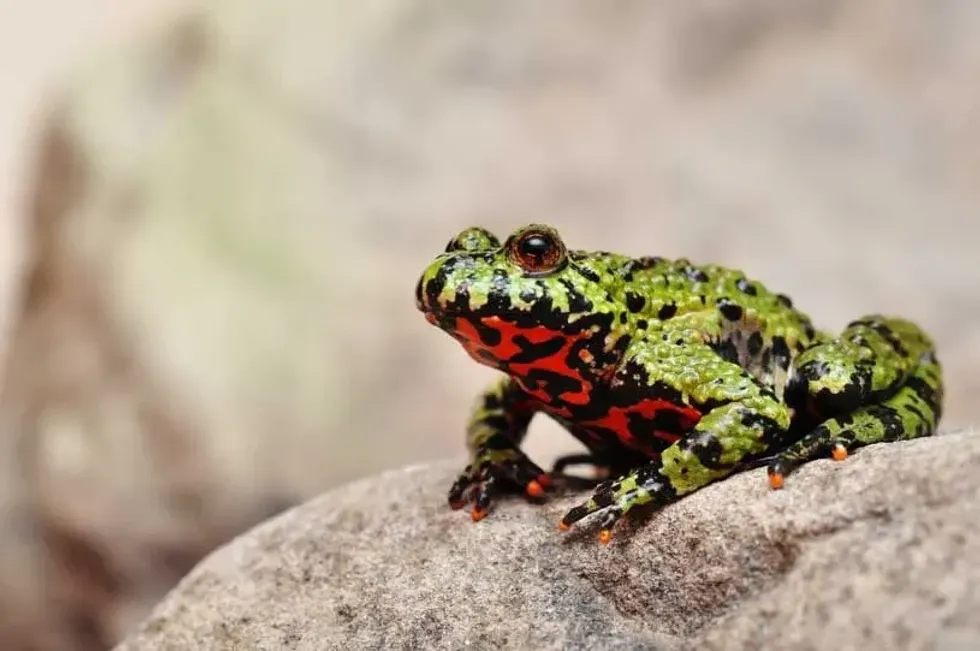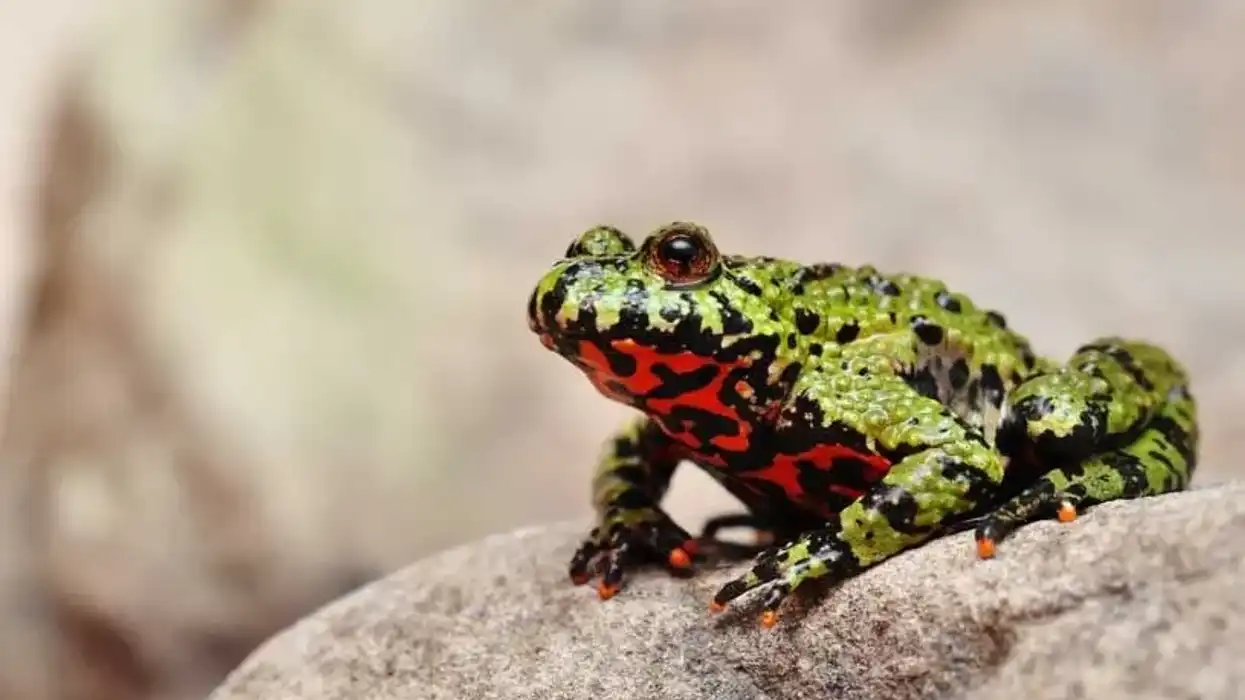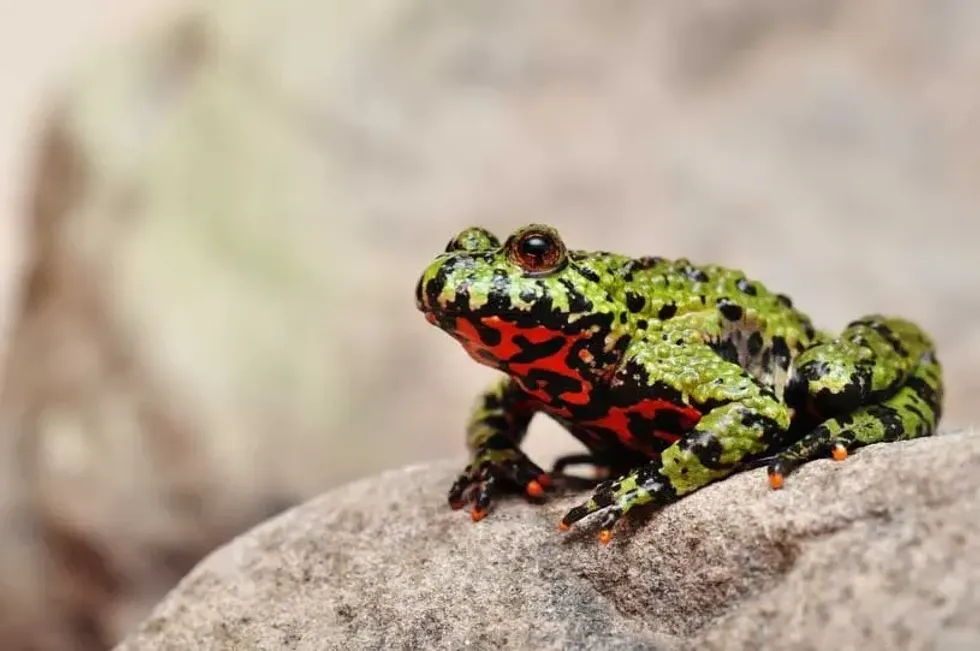Fun Fire-bellied Toad Facts For Kids
Content
- What type of animal is a fire-bellied toad?
- What class of animal does a fire-bellied toad belong to?
- How many fire-bellied toads are there in the world?
- Where does a fire-bellied toad live?
- What is a fire-bellied toad's habitat?
- Who do fire-bellied toads live with?
- How long does a fire-bellied toad live?
- How do they reproduce?
- What is their conservation status?
- What do fire-bellied toads look like?
- How cute are they?
- How do they communicate?
- How big is a fire-bellied toad?
- How fast can a fire-bellied toad run?
- How much does a fire-bellied toad weigh?
- What are the male and female names of the species?
- What would you call a baby fire-bellied toad?
- What do they eat?
- Are they dangerous?
- Would they make a good pet?
- Did you know...
- Contact with fire-bellied toads
- Fire-bellied toads as pets
Fire-bellied toads consist of a group of six species of toads, all of whom belong to the genus Bombina. Fire-bellied toads don't actually carry fire in their stomachs (like dragons) but are named so due to their unique appearance.
Fire-bellied toads have bright red, yellow, or black patterns on their bellies, which serve as a warning sign to potential predators. When faced with a potential predator, fire-bellied toads use what is called the Unken reflex.
While using that tactic, they arch their backs to prominently showcase their colorful belly patterns in an effort to scare their predators away. Their colorful patterns are a signal to other predators of their poisonous nature, thereby keeping them at bay.
There are a total of six species of fire-bellied toads and we have mentioned the most important ones below. Bombina bombina is the European fire-bellied toad. Bombina microdeladigitora is the Chinese fire-bellied toad.
Bombina orientalis is the Oriental fire-bellied toad. Fire-bellied toads are found in Europe and Asia and are typically located near stagnant waters. Keep reading to know plenty more interesting facts about fire-bellied toads later on in the article be it about pet fire-bellied toad facts or wild fire-bellied toad facts.
You may also check out the fact files on marine toads and tree frogs from Kidadl.
Fire-bellied Toad Interesting Facts
What type of animal is a fire-bellied toad?
The fire-bellied toad, Bombina, is an amphibian belonging to the genus of Bombina. Its scientific name is also the same as its genus and is known as Bombina.
Though its name has toad in it and is mistaken for other frogs at times, its anatomic structure differs from most known frogs and toads.
When faced with danger, it reveals its red or red-orange underbelly to warn its predators that it is poisonous in an effort to scare them off. This species of toad is spotted mainly in the northeastern regions.
What class of animal does a fire-bellied toad belong to?
The fire-bellied toad is an amphibian that belongs to the Animalia kingdom and the Bombina genus, with its class being Amphibia.
How many fire-bellied toads are there in the world?
Currently, there is no clear-cut data that records the exact population of fire-bellied toads. Even among fire-bellied toads, there exist several subcategories such as the commonly known Bombina orientalis (also known as the Oriental fire-bellied toads).
These subspecies are named based on the location they reside in. All these subspecies have to be accounted for when figuring out a rough estimate of the fire-bellied toads' population.
Though, studies have shown that fire-bellied toads, especially the Oriental fire-bellied toads, scientifically known as Bombina orientalis, are widely distributed in the waters of the northeastern regions.
Where does a fire-bellied toad live?
Fire-bellied toads reside in small water bodies and are spotted in ponds, lakes, and streams. They are mainly found in the waters surrounding the northeastern regions and can even be found near water located at high altitudes in those regions.
If we were to focus more on the locations where they are found, we will discover that fire-bellied toads are native residents of China. They are also present in other countries such as South Korea, North Korea, and a few regions of Russia.
The ones present in a few of the eastern countries are scientifically referred to as Bombina orientalis, also known as the oriental fire-bellied toads. The bellied toad, Bombina orientalis, are perceived as the more beautiful of its species by several.
What is a fire-bellied toad's habitat?
Fire-bellied toads don't inhabit huge water bodies such as oceans. They prefer to live in slow-moving or stagnant waters. They are often spotted in water bodies such as lakes, ponds, and streams. They also tend to be found in waters located in high altitudes and can even live at altitudes as high as 1.8 mi (3 km).
Though, being amphibians, it will come as a surprise to none that fire-bellied toads, apart from having a home in shallow waters, also live on land. They can be found in deciduous forests, open meadows, and even swampy bushlands.
Who do fire-bellied toads live with?
The toad (fire-bellied) lives a solitary lifestyle while adult. As vulnerable tadpoles, they tend to stick together and have algae and nearby vegetation as their food before their metamorphosis into their adult forms to nurture themselves.
How long does a fire-bellied toad live?
It has been determined that on average, a bellied toad fire lives between 12-15 years if they were to survive out in the wild. However, if nurtured carefully under lab conditions, they can surpass their natural life spans.
When raised in captivity, it was discovered that they lasted way longer than when they lived in the wild. In fact, some even lived until they were a whopping 20 years old.
How do they reproduce?
When fire-bellied toads are in their breeding season, the male fire-bellied toads will sport dark patches on the skin of their inner arms called nuptial pads. Along with growing these pads, they also let out mating calls in search of a potential mate.
Research suggests that their mating calls differ from other toads or frogs. Rather than the typical croaking made by frogs and toads while in heat, it is often thought that their mating calls sound akin to dogs barking.
However, it is advised to be careful if you intend on having a fire-bellied toad as a pet during the mating season. While in heat, the male fire-bellied toads will grab anything that they come into contact with be it plants or even your fingers.
Just like how their mating calls differ from most toads and frogs, their breeding process is also different from their cousins in the Amphibia kingdom.
While most male toads grasp the front legs of their mate, the male fire-bellied toads grasp the rear legs of their potential mating partners.
If the female fire-bellied toad was not receptive to the courting of their male counterpart, they would display that by straightening their legs out and vibrating their body. If the female made this movement, the male fire-bellied toad would be forced to leave the current partner and try to find another potential mate.
This unusual reproductive process, first noticed in oriental fire-bellied toads, was later on named inguinal amplexus among researchers.
The fire-bellied toads' breeding seasons typically begin from late April to the middle of summer. While in heat, the male fire-bellied toads will do their mating calls throughout the whole day but the mating would mainly take place in the early evening.
Regardless of whether they are out in the wild, raised in captivity, or kept as a pet, they require no external motivation to mate.
During the breeding process, the female fire-bellied toad will deposit their fertilized eggs in several clusters that will be close to vegetation nearby. The younger female fire-bellied toads will lay a rough estimate of 70 eggs while the older ones will lay an average of 120 eggs.
After a span of 4-10 days, the embryos inside the eggs would hatch and give birth to the tadpoles, as are baby toads called.
After hatching from their eggs, the tadpoles will nurture themselves of plants and algae and grow rapidly for the next 45 days. After the 45 day period is over, the tadpoles will metamorphose into their adult forms.
What is their conservation status?
Fire-bellied toads, as opposed to several other species of frogs or toads, are not an endangered species and have been deemed Least Concern by environmental specialists. Hence, it is safe to assume that their population will not be facing any immediate threats and this unique species will continue to live on.
However, studies have shown that their population is currently on the decline, most possibly due to various reasons such as habitat loss. But there is no need for immediate concern since they will not be facing extinction any time even into the near future.
Fire-bellied Toad Fun Facts
What do fire-bellied toads look like?
Fire-bellied toads have very colorful bellies, as signified by their name. Fire-bellied toads often have red patterns, red-orange, or yellow, and black patterns on their bellies.
The rest of their body is primarily bright green or dark brown, depending on the individual species. Though, if they were raised in the wild, they will be born with their colorful appearance but the colors will be slightly dulled.
Their colorful and striking appearance is a defense mechanism. The patterns on their bellies signal potential predators about their poison and their foul taste, thereby scaring them away.

How cute are they?
As the fire-bellied toad is a subset of frogs, we would assume that they look alike. However, fire-bellied toads have beautiful and striking patterns on their bellies, which gives them an appearance like no other.
These are surely one of the most unique-looking among most frogs and toads. However, if you typically don't find frogs and toads cute, fire-bellied toads may not appeal to you much.
How do they communicate?
Fire-bellied toads communicate using auditory signaling. Communication is mostly needed during the mating season. Mating calls differ based on species and gender.
When fire-bellied toads receive mating calls from their species, they let outcalls in response. These response calls are timed such that they don't overlap with other calls.
Using these calls, potential mates can locate each other in order to reproduce. It is interesting to note that female fire-bellied toads do not make any noises. It is up to the males of the species to broadcast their location and hope that females will change their way.
How big is a fire-bellied toad?
Fire-bellied toads reach a maximum length of just 2 in (5 cm). They are far smaller than the common frogs and toads one sees outdoors. In fact, an average frog is two to three times bigger than an average fire-bellied toad.
How fast can a fire-bellied toad run?
Fire-bellied toads, similar to other toads, crawl to their destination instead of hopping as frogs do. Therefore, they don't have muscular hind legs that can allow them to attain very high speeds. In fact, fire-bellied toads can reach a maximum speed of 5 mph (8 kph).
How much does a fire-bellied toad weigh?
A fire-bellied toad typically weighs between 0.7-2.8 oz (20-80 g).
What are the male and female names of the species?
Fire-bellied toads do not have separate names based on gender. In fact, males are almost indistinguishable from females, with the only way to tell them apart are their mating calls and the thickness of their forearms.
What would you call a baby fire-bellied toad?
A baby fire-bellied toad is called a toadlet or tadpole.
What do they eat?
Predators of the fire-bellied toad include snakes, foxes, and birds.
Are they dangerous?
Fire-bellied toads have the coloration on their bellies as a signal to potential predators about their dangerous nature. Similar to other toads, fire-bellied toads do contain poison near the surface of their skin. The poison is just a self-defense mechanism; they don't use the poison to hunt and aren't venomous.
Would they make a good pet?
Fire-bellied toads would make excellent pets and are often available through the pet trade. Their colorful appearance lends them a striking look, though their rough skin might not appear appealing to many.
They are well suited to be raised in captivity. They are very small and don't require large cages. They have a voracious appetite, which means they would be willing to have almost anything edible as their food.
Though, they do require dechlorinated water. Adults require food three to four times a week and primarily eat insects. They are very easy to mate.
Lastly, they aren't dangerous to humans and live for a sufficiently long 12-15 years. As a matter of fact, fire-bellied toads are quite common pets in the US and they are often involved in the pet trade.
Did you know...
As a scare away tactic, fire-bellied toads arch their backs and flip upside down. Predators, upon seeing the bright underbelly, leave them alone.
Contact with fire-bellied toads
Fire-bellied toads have poison under the surface of their skin as a self-defense mechanism against predators. Its poison is quite weak and will only harm those who ingest the toad.
Fire-bellied toads aren't venomous; they do not actively inject their poison into other living beings in close proximity. Therefore, it shouldn't be a problem holding or even petting fire-bellied toads in your bare hands. Their poison isn't lethal for humans, but it might cause skin irritation in some people.
Fire-bellied toads as pets
This section will deal with fire-bellied toad care and what to expect from having one as a pet. To be frank, fire-bellied toads can turn out to be excellent pets and are fascinating animals. They can be raised in captivity.
They do not require constant attention. They need food three to four times a week. Their diet consists of insects you will find for quite cheap on the market.
They are exceptionally beautiful with vibrant colors, albeit the textured skin. They require a 10 gal (37.8 l) tank for their home.
They don't need heating and require cage cleaning once a week. Fire-bellied toads can cost from $15-$25. Similar to most pets, they do require a bit of care but it is worth it if you truly want one as your pet.
Here at Kidadl, we have carefully created lots of interesting family-friendly animal facts for everyone to discover! Learn more about some other amphibians from our pool frog facts and caecilian facts pages.
You can even occupy yourself at home by coloring in one of our free printable Fire-bellied toad coloring pages.
We Want Your Photos!
More for You
Bachelor of Arts specializing in English Literature

Akinwalere OlaleyeBachelor of Arts specializing in English Literature
As a highly motivated, detail-oriented, and energetic individual, Olaleye's expertise lies in administrative and management operations. With extensive knowledge as an Editor and Communications Analyst, Olaleye excels in editing, writing, and media relations. Her commitment to upholding professional ethics and driving organizational growth sets her apart. She has a bachelor's degree in English Literature from the University of Benin, Edo State.
Disclaimer
1) Kidadl is independent and to make our service free to you the reader we are supported by advertising. We hope you love our recommendations for products and services! What we suggest is selected independently by the Kidadl team. If you purchase using the Buy Now button we may earn a small commission. This does not influence our choices. Prices are correct and items are available at the time the article was published but we cannot guarantee that on the time of reading. Please note that Kidadl is a participant in the Amazon Services LLC Associates Program, an affiliate advertising program designed to provide a means for sites to earn advertising fees by advertising and linking to Amazon. We also link to other websites, but are not responsible for their content.
2) At Kidadl, we strive to recommend the very best activities and events. We will always aim to give you accurate information at the date of publication - however, information does change, so it’s important you do your own research, double-check and make the decision that is right for your family. We recognise that not all activities and ideas are appropriate for all children and families or in all circumstances. Our recommended activities are based on age but these are a guide. We recommend that these ideas are used as inspiration, that ideas are undertaken with appropriate adult supervision, and that each adult uses their own discretion and knowledge of their children to consider the safety and suitability. Kidadl cannot accept liability for the execution of these ideas, and parental supervision is advised at all times, as safety is paramount. Anyone using the information provided by Kidadl does so at their own risk and we can not accept liability if things go wrong.
3) Because we are an educational resource, we have quotes and facts about a range of historical and modern figures. We do not endorse the actions of or rhetoric of all the people included in these collections, but we think they are important for growing minds to learn about under the guidance of parents or guardians.







